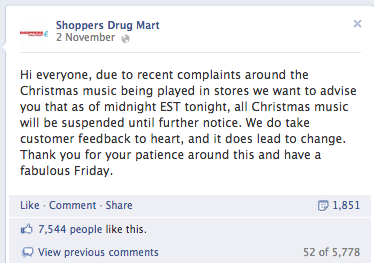
Late last week Canadian retail chain Shoppers Drug Mart announced they are keeping the Christmas music in their stores under wraps “until further notice”. The news was greeted with good cheer by most consumers and with high profile positive coverage in most major media outlets across the country.
Which is all well and good – I’m as happy as anyone to get a reprieve, however brief, from the parum-pa-pum-pum. But what makes it an Internet marketing story?
Two things.
1) The company made the announcement – which, again, got picked up by major media across the country – not through a traditional media release or PR campaign, but via their Facebook page. Shoppers didn’t even do an official media release around the announcement. And this announcement got more mainstream pick-up than their last 5 official media releases combined.
2) The decision to make the announcement was largely driven by social media.
Now, your small business may not be able to move media mountains with a single Facebook post. But with a consistent commitment to some of the principles that Shoppers used, you should be able to move the needle on your business results.
Step 1: Build Your Social Media Network
We don’t really have the time or the space here, but there are tons of primers out there for building your social media marketing presence. The key thing to know, in this case, is that Shoppers’ message got traction because a) they had a strong initial social audience who saw their message and passed it around [and, yes, b) they have a strong national brand to leverage].
Step 2: Monitor Social Media Channels
The reason Shoppers Drug Mart could have confidence that delaying the Christmas music onslaught is that they were listening to social media channels and not just pushing out their message.
If Shoppers was using a social media monitoring tool – and for sure they were – to track consumer feelings around keywords like ‘holiday shopping’ they would have seen – did see – their screens glowing red with negative tweets, Facebook posts, blog posts and more with messages from people who are fed up with hearing Feliz Navidad on Día de los Muertos.
So they knew, before the said a single thing, that early season holiday music was a hot button topic that was going to get a huge reaction when they weighed in on it.
So what are some of the top words or ideas that people use when they’re talking about your industry? (Knowing this will be important for your SEO and other Internet marketing initiatives, too). And what’s the conversation like around those words and ideas? What are people saying?What gets people excited? What makes them happy? What makes them furious?
You need to monitor this conversation in an ongoing way. If Shoppers had taken a “one and done” approach to monitoring 3 months ago, they would have completely missed the insight that drove this week’s win.
(And a bit of a plug here: all of Fruition’s monthly internet marketing package subscribers get monthly reporting on key social media terms as part of their package).
Step 3: Influence the conversation
Once you know what people are talking about and what they’ve invested their emotions in, you have some clues for what to say to them when it’s your turn to talk.
Now you know what your customers’ pain points are and what makes them do the “happy dance” because you’ve done your research. What is it that you do – or that, like Shoppers, you can do easily – to address that pain or to evoke that dance? Now’s the time to tell that audience of yours that you spent time building all about it. And if it is something they really care about, they’ll tell other people, too.
Step 4: Monitor and measure the Internet marketing results
This isn’t a one-off maneuver. You’re going to want to keep doing this over time. And you’re going to want to get better at it each time. That’s why you’re going to set goals and why your going to measure results. Did this drive more traffic to your door or Web site? Did this drive sales? Did it increase positive mentions of your brand in social media or mainstream media?
Like everything in your Internet marketing playbook, try some slightly different approaches – do more of the things that work well and do less of the things that work less well.